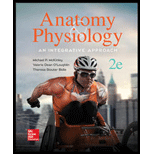
Concept explainers
____ 1. Which tissue contains a calcified ground substance and is specialized for structural support?
- a. muscle tissue
- b. dense regular connective tissue
- c. areolar connective tissue
- d. bone connective tissue
Introduction:
Connective tissue is a type of fibrous tissue which contain insoluble matrix, in which collagen are assembled. It protects and supports the organs and the body. It also stores the energy, binds the organ together, and helps in maintaining the immunity.
Answer to Problem 1DYKB
Correct answer:
Bone connective tissue contains a calcified ground substance and is specialized for structural support. Therefore, option d. is correct.
Explanation of Solution
Reason for the correct statement:
Option d. is given as “bone connective tissue”. Bone connective tissue is hard and contains calcified matrix of collagen fibers. Its function is to support and protect the layers of muscles, and store calcium. Hence, bone connective tissue is characterized by calcified ground substances, and it provides structure and support to the body frame work.
Hence, option d. is correct.
Reasons for incorrect statements:
Option a. is given as “muscle tissue”. Muscle tissue helps in movement by contraction and it does not contain any ground substance. Hence, option a. is incorrect.
Option b. is given as “dense regular connective tissue”. Dense regular connective tissue is present in dermis of skin and contains collagen fibers and fibroblast in their structure. Hence, option b is incorrect.
Option c. is given as “areolar connective tissue”. Areolar type of connective tissue is present in subcutaneous layer of skin, and contains elastin fibers, collagen fibers, and reticular fibers. Hence, option c is incorrect.
Hence, options a, b, and c are incorrect.
Bones connective tissues are the connective tissue which provides support and structural frame work to the body.
Want to see more full solutions like this?
Chapter 5 Solutions
Anatomy & Physiology: An Integrative Approach
- In one paragraph show how atoms and they're structure are related to the structure of dna and proteins. Talk about what atoms are. what they're made of, why chemical bonding is important to DNA?arrow_forwardWhat are the structure and properties of atoms and chemical bonds (especially how they relate to DNA and proteins).arrow_forwardThe Sentinel Cell: Nature’s Answer to Cancer?arrow_forward
- Molecular Biology Question You are working to characterize a novel protein in mice. Analysis shows that high levels of the primary transcript that codes for this protein are found in tissue from the brain, muscle, liver, and pancreas. However, an antibody that recognizes the C-terminal portion of the protein indicates that the protein is present in brain, muscle, and liver, but not in the pancreas. What is the most likely explanation for this result?arrow_forwardMolecular Biology Explain/discuss how “slow stop” and “quick/fast stop” mutants wereused to identify different protein involved in DNA replication in E. coli.arrow_forwardMolecular Biology Question A gene that codes for a protein was removed from a eukaryotic cell and inserted into a prokaryotic cell. Although the gene was successfully transcribed and translated, it produced a different protein than it produced in the eukaryotic cell. What is the most likely explanation?arrow_forward
- Molecular Biology LIST three characteristics of origins of replicationarrow_forwardMolecular Biology Question Please help. Thank you For E coli DNA polymerase III, give the structure and function of the b-clamp sub-complex. Describe how the structure of this sub-complex is important for it’s function.arrow_forwardMolecular Biology LIST three characteristics of DNA Polymerasesarrow_forward
 Biology (MindTap Course List)BiologyISBN:9781337392938Author:Eldra Solomon, Charles Martin, Diana W. Martin, Linda R. BergPublisher:Cengage Learning
Biology (MindTap Course List)BiologyISBN:9781337392938Author:Eldra Solomon, Charles Martin, Diana W. Martin, Linda R. BergPublisher:Cengage Learning
 Human Biology (MindTap Course List)BiologyISBN:9781305112100Author:Cecie Starr, Beverly McMillanPublisher:Cengage Learning
Human Biology (MindTap Course List)BiologyISBN:9781305112100Author:Cecie Starr, Beverly McMillanPublisher:Cengage Learning Human Physiology: From Cells to Systems (MindTap ...BiologyISBN:9781285866932Author:Lauralee SherwoodPublisher:Cengage Learning
Human Physiology: From Cells to Systems (MindTap ...BiologyISBN:9781285866932Author:Lauralee SherwoodPublisher:Cengage Learning





